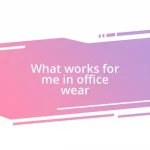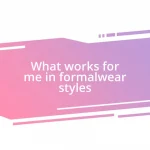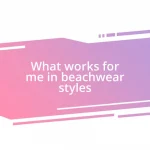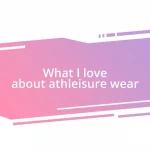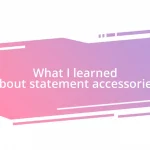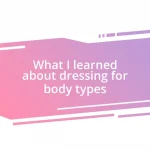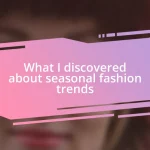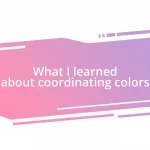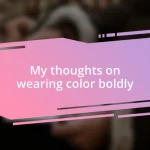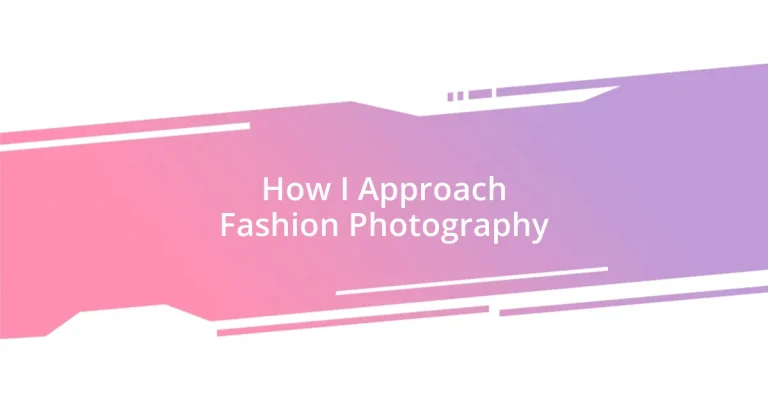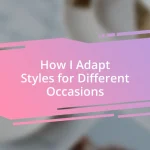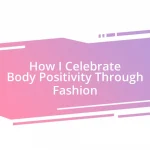Key takeaways:
- Fashion photography involves storytelling, creative composition, and authentic connections with subjects to capture impactful images.
- Developing a unique style requires exploration, experimentation, inspiration gathering, regular practice, and seeking constructive feedback.
- Successful collaborations hinge on clear communication, establishing rapport, and fostering a comfortable environment for creative exchange.
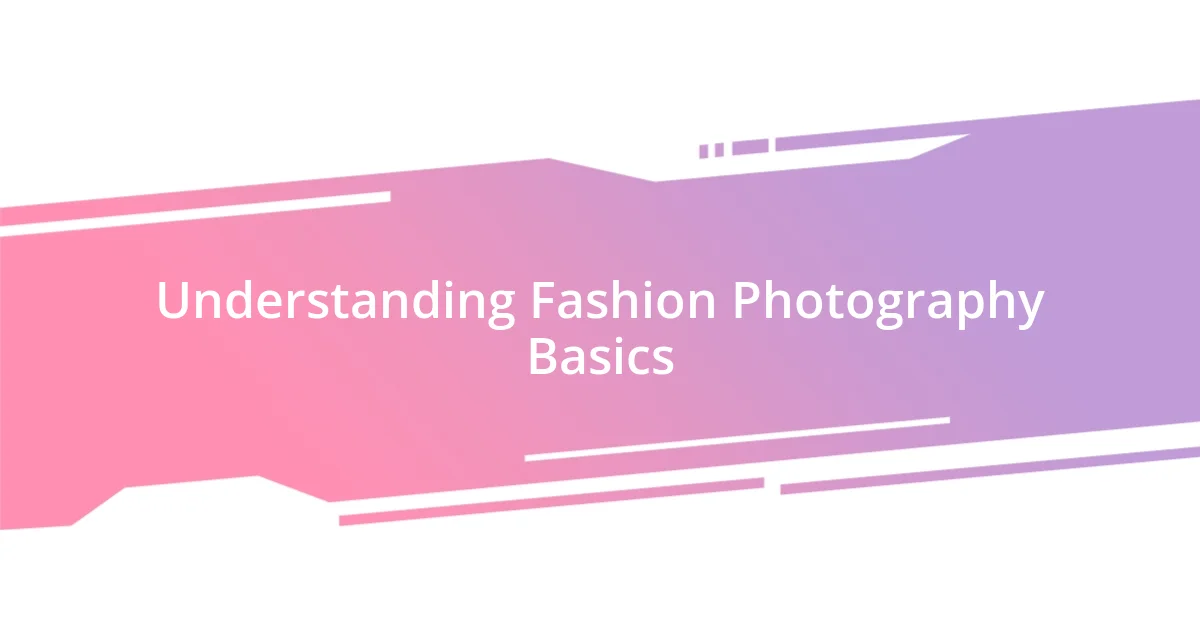
Understanding Fashion Photography Basics
Fashion photography is about more than just capturing clothes; it’s about telling a story. When I first started, I felt overwhelmed by the possibility of freezing a moment that conveyed the essence of both the fashion and the model. I remember a shoot where the lighting wasn’t cooperating, yet I realized this challenge pushed me to explore creative angles that ultimately made the images more dynamic.
Composition is another critical aspect. I still vividly recall the first time I understood the rule of thirds—it transformed my perspective. I suddenly started envisioning my shots differently, allowing the negative space to breathe and add depth to the photographs. Isn’t it fascinating how a simple shift in thinking can elevate your work to a new level?
Lastly, connecting with your subject is vital. Some of my most memorable images come from moments where I simply allowed the model to express themselves, capturing authentic emotions rather than posed expressions. Have you ever felt that magic when the camera clicks and you know you’ve frozen something special? It’s that connection that can make a fashion photograph resonate on a deeper level.
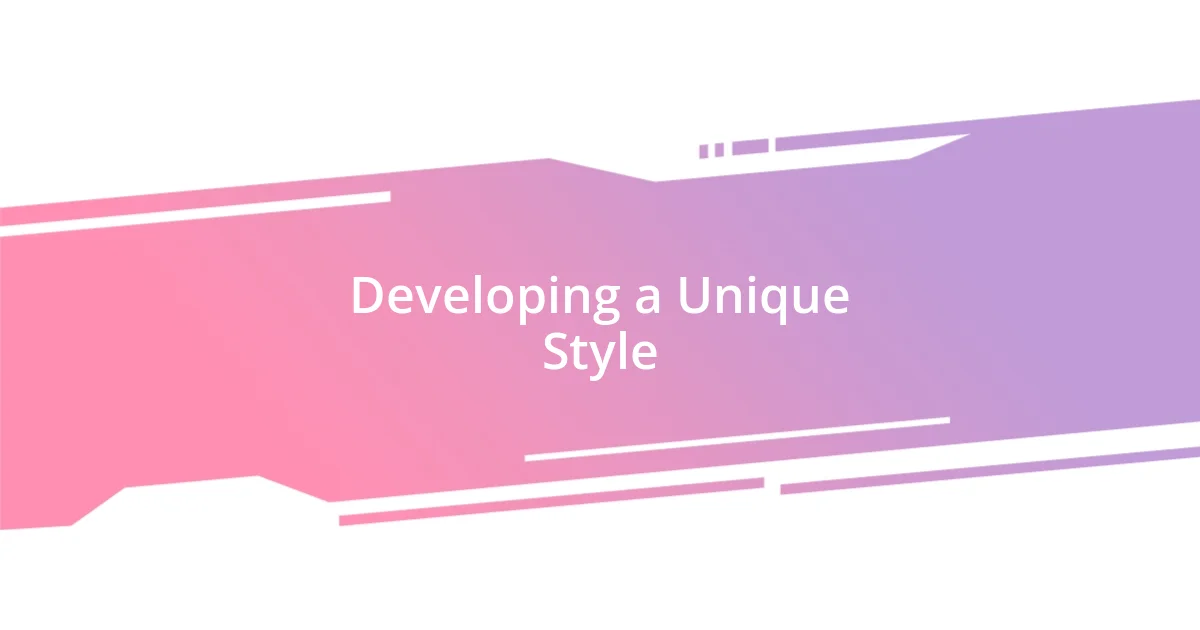
Developing a Unique Style
Finding a distinctive voice in fashion photography is an ever-evolving journey. I recall an early experience where I tried to imitate popular photographers, hoping to achieve the same results. It didn’t take long for me to realize how crucial it is to carve out my own niche. When I began experimenting with unorthodox color palettes and unconventional settings, I discovered a style that felt authentic. Every shoot became a playground for my creativity.
To enhance your unique style, consider these aspects:
– Explore Different Genres: Step outside fashion; try portrait or editorial photography to broaden your perspective.
– Experiment with Editing: Play with different editing software to find a post-processing aesthetic that resonates with you.
– Gather Inspiration: Create mood boards from various sources: art, nature, or street photography to fuel your creative fire.
– Practice Regularly: Consistency helps refine your style; the more you shoot, the more you discover your preferences.
– Seek Feedback: Engage with fellow photographers; their insights can reveal blind spots in your work and inspire growth.
Each of these strategies has been a crucial step in my personal evolution, helping to shape the lens through which I see the world.
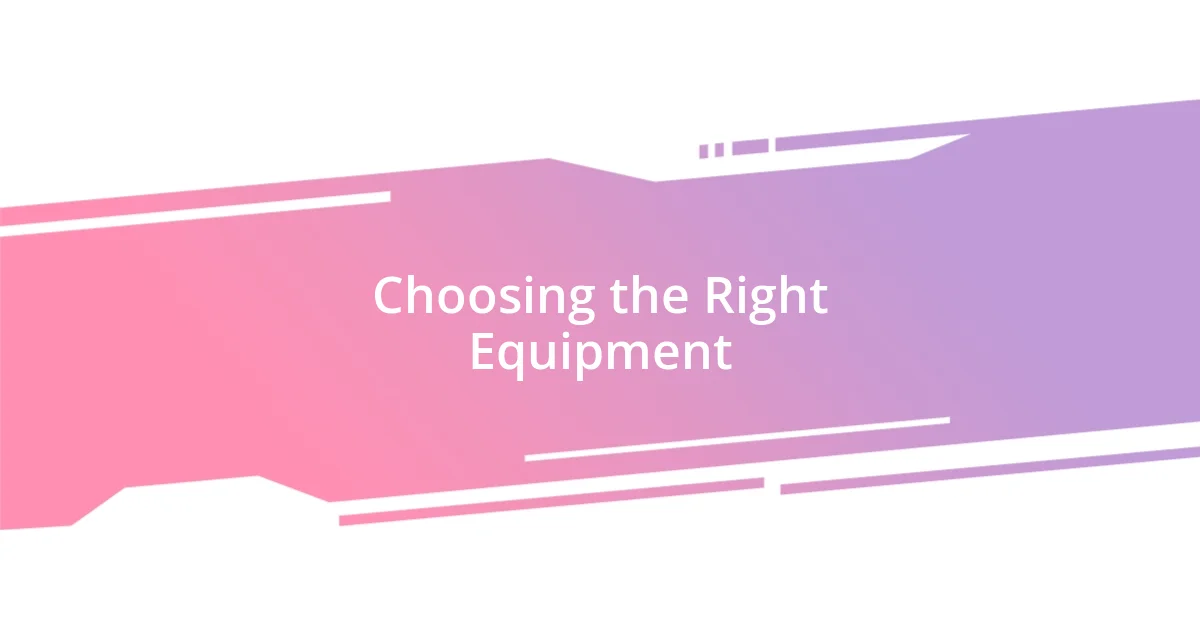
Choosing the Right Equipment
Choosing the right equipment is a fundamental step in fashion photography. I remember the first time I upgraded from a kit lens to a prime lens; it was like unlocking a new level in a video game. The sharpness of the images and the ability to shoot in low light transformed my style and approach. Having the right gear can profoundly affect the outcome, not just in technical terms but in how I feel while shooting.
When selecting your camera body, consider what suits your style best. I’ve found that full-frame cameras often deliver better image quality—especially in challenging lighting. However, a high-quality crop sensor can also yield stunning results, particularly with the right lenses. It always comes down to personal preference and comfort—what feels right in your hands can inspire confidence during a shoot.
Ultimately, don’t overlook accessories like reflectors and diffusers. They might seem minor, but they’ve saved many of my shoots from harsh lighting disasters. I once shot outdoors on a sunny day without any diffusers, and the results were harsh shadows on my model’s face. Investing in these tools has since allowed me to play with light creatively, softening it and enhancing the overall mood.
| Equipment | Notes |
|---|---|
| Camera Body | Consider a full-frame for better quality, but crop sensors can work well too. |
| Lenses | Prime lenses for sharpness, while versatile zooms offer flexibility. |
| Accessories | Reflectors and diffusers can enhance lighting quality significantly. |
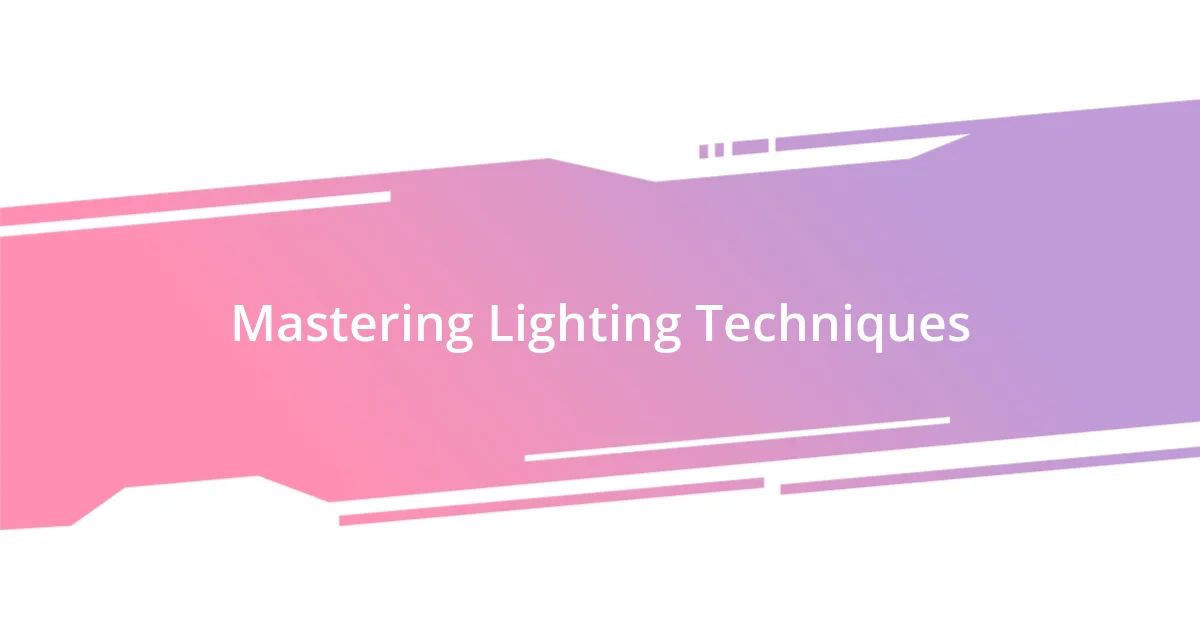
Mastering Lighting Techniques
Lighting is everything in fashion photography; it can elevate a simple image into something breathtaking. I vividly remember one shoot where I faced a cloudy day. Instead of sulking, I decided to embrace the gloom and used it to create a moody atmosphere. That experience taught me that even unfavorable conditions can become part of your artistic toolbox. Have you ever experimented with the ambient light instead of fighting against it?
Understanding the direction and quality of light is key. I like to start by observing how it interacts with my subject. Soft, diffused light creates a flattering look, while harsh light can add drama. I once shot a series where I utilized late afternoon sunlight, casting long shadows that framed my model beautifully. It was a serendipitous moment that reminded me how crucial it is to be attuned to my surroundings. What lighting scenarios have sparked creativity for you?
Maintaining control over your light source is essential, whether using natural light or studio setups. I often carry a portable flash to help fill in shadows when needed. There was a particular shoot where I placed a flash behind my model, creating a stunning rim light effect that highlighted her silhouette. This kind of technique invites a more dynamic composition, making the viewer pause and take in the details. Have you thought about how mastering lighting can transform your images? Dive into it; the results are always rewarding.
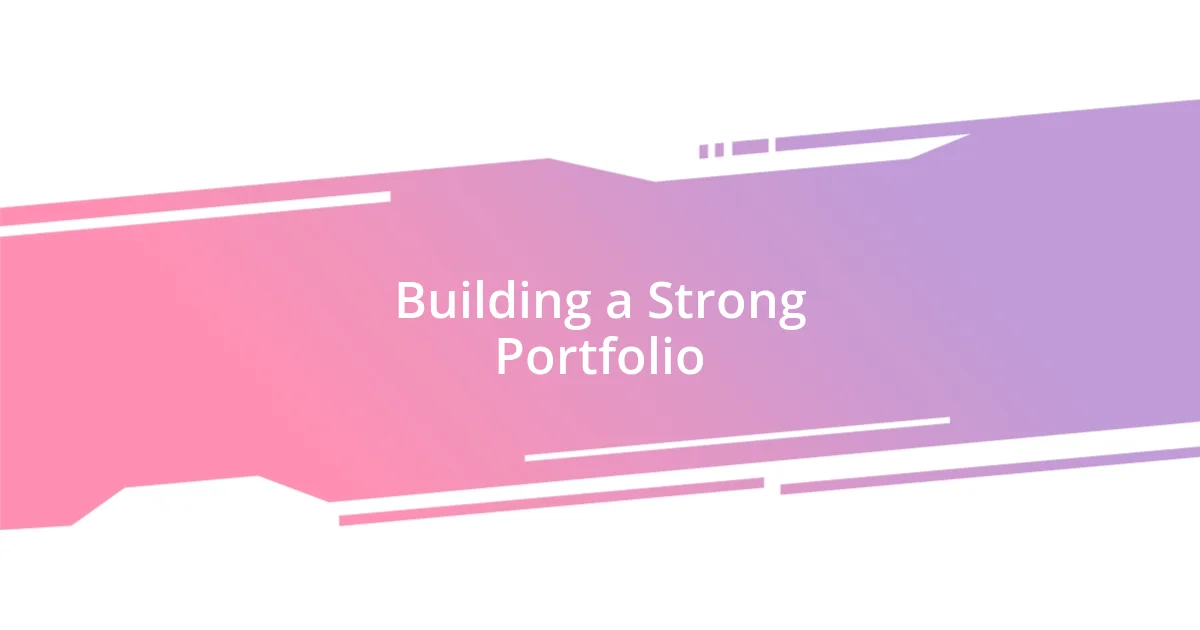
Building a Strong Portfolio
Building a strong portfolio is about showcasing not just your technical skills but also your unique style. I recall when I first decided to curate my portfolio; it felt daunting but exhilarating. I sifted through hundreds of images, trying to find that perfect balance between variety and coherence. It’s essential to include a mix of well-composed shots, candids, and experimental work that reflects your vision. Have you thought about what moments represent you as a photographer?
I believe that showing a range of looks and settings can draw in potential clients. During my early days, I included fashion editorials alongside street style. This crossover helped me attract diverse clients, as they appreciated my versatility. Choosing images that resonate with your desired audience is crucial; it makes your portfolio not just a collection of photos, but a narrative of your artistic journey. What stories are you aiming to tell through your portfolio?
Finally, don’t hesitate to revisit and refine your portfolio regularly. As I grew in my craft, I realized that some early images no longer aligned with my current style. Each edit felt like a mini-exhibition, allowing me to reflect on my progress and re-envision my artistic path. Trust me, this kind of self-evaluation can be transformative. Have you taken the time to reassess your work lately? It’s a process that not only enhances your portfolio but also fuels your growth as a photographer.
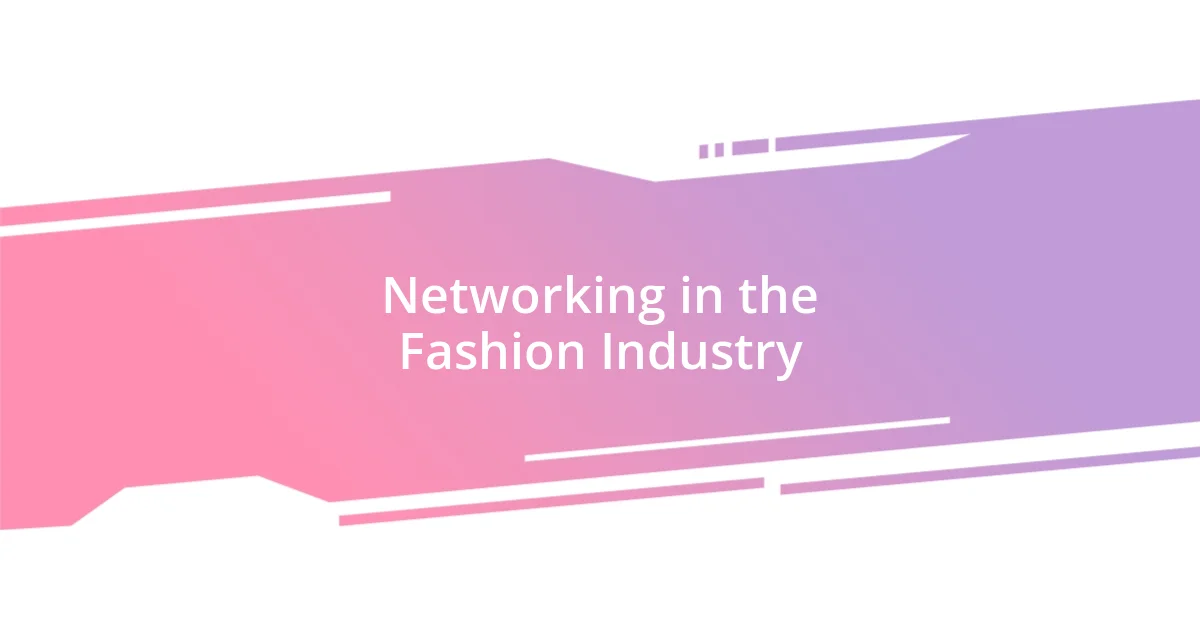
Networking in the Fashion Industry
Establishing connections in the fashion industry can be a game-changer. I remember attending a small gallery opening where I struck up a conversation with a stylist who later asked me to collaborate on a project. That encounter turned into a valuable partnership that helped elevate my work. Have you ever had a chance meeting that shifted your creative journey?
Networking isn’t just about exchanging business cards; it’s about nurturing relationships. I often reach out to fellow photographers and creatives, sharing insights and even brainstorming new ideas. I find that the more I invest in these relationships, the more opportunities arise. How often do you follow up with someone after a first meeting? I try to reconnect regularly, whether it’s through social media or a quick coffee chat, and those conversations often lead to exciting collaborations.
Don’t underestimate the power of social media as a networking tool. I’ve found platforms like Instagram to be incredibly effective. Sharing my work and engaging with others not only expands my reach but also opens doors to connect with brands and influencers. I recall being featured in a style blog simply because I took the time to interact with its creator. It’s amazing how a little engagement can lead to significant opportunities. What are your thoughts on leveraging social media for networking?
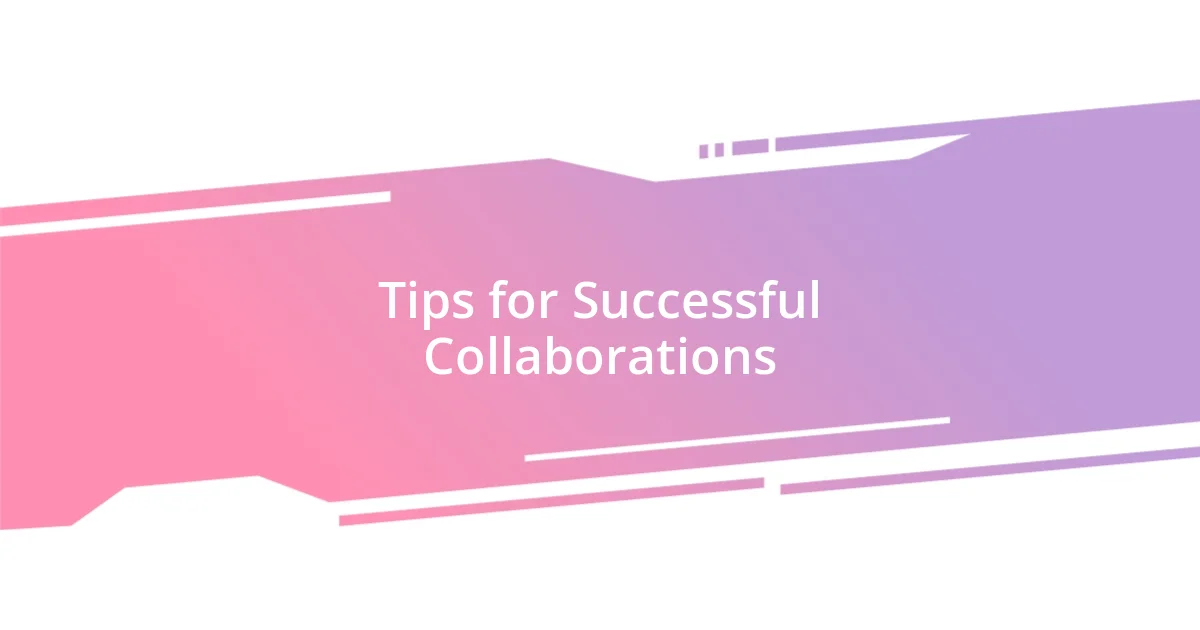
Tips for Successful Collaborations
Collaboration in fashion photography is as much about alignment of vision as it is about technique. I vividly recall a project where I worked with a designer who had an incredible sense of aesthetics, but we initially struggled to see eye to eye on the concept. Through open discussions and mood boards, we communicated our ideas, ultimately blending our styles into something unique. Have you ever had a creative difference that turned out to be a blessing in disguise?
Clear communication is the backbone of any successful collaboration. I’ve learned that expressing my ideas and listening to others can prevent misunderstandings. In one instance, I was working with a makeup artist on a shoot, and after sharing a few references, our creative flow ignited. We bounced ideas off each other, refining the looks until we created something truly special. How often do you prioritize sharing your thoughts during collaborations?
Creating a comfortable environment is crucial for collaboration to thrive. I often invite my team for coffee before a shoot, fostering a relaxed vibe that encourages everyone to share their input freely. One memorable shoot had a relaxed atmosphere, where laughter and creativity flourished, resulting in some of my best work to date. When everyone feels valued and heard, the energy shifts, and magic happens. What strategies do you use to build that rapport before diving into a project?
